
[Last Update: June 28th, 2018]

|
History of the Pentagram
Symbol of Ages
Copyright © 2006 C.E. by Dustin Jon Scott
[Last Update: June 6th, 2018]
I. The History of the Pentagram
The recurrent theme of the five-pointed star is one of the most mysterious, universal, and, paradoxically, largely ignored elements of human history; and is therefore one of the least understood, despite its indubitable significance. It made its appearance in the first known human civilization and is used today as the insignia of various institutions; from modern Pagan religions such as Wicca to Abrahamic faiths such as Judaism, Christianity, and Islam; from bronze-age occult traditions like Judeo-Christian Gnosticism to secret societies like the Freemasons; from underground Anarchist movements like the so-called Malandanti of Medieval Italy to modern, ultra-authoritarian governments considered major world-powers such as the United States of America. It has appeared in every major civilization, from the city seals of the great city-states of ancient Sumer, on into the later Chaldean civilizations like Akkadia, the Babylonian Empire, and eventually post-Chaldean Judea, to the tombs, hieroglyphs, and cult emblems of the Egyptian Old Kingdom and the ancient Egyptian dynasties, to the millennia-old syllabary of the Chinese, to the ancient Mesoamerican civilization of the Maya, to the banner of the Muslim faith and the united infra-national states of modern-day North America, to the insignia of many modern militaries and military branches such as the American United States’ Air Force; from Africa to Eurasia, from South America to North America, from Oceania to Antarctica — there exists no continent on which this symbol remains absent. The significance, oft ignored due to the expectation that every culture place great mythological or symbolic importance on the stars, lies in the fact that the human eye perceives stars as having only four symmetrical points or even being mere round dots, while round and four-pointed star symbols are almost nonexistent compared to the ubiquity of the pentagram.
Sumerian Pentagrams

Sumer
circa 3500 B.C.E.
The oldest known pentagrams appeared in ancient Sumer approximately 5,500 years ago. Pictured, from left to right: pictographs from the pre-cuneiform Uruk IV period circa 3500 B.C.E., a cuneiform character from Fara (Shuruppak) circa 2600 B.C.E., and another from Sargon, circa 2350 B.C.E. Primitive pentagrams such as these could be found frequently on potsherds around the area of Unug, more frequently still on proto-cuneiform tablets dating to the Jemdet Nasr or Uruk III period (circa 3100-2900 B.C.E.) of the city of the same name with a total of forty-six occurrences on thirty-three of the two hundred and forty-three known tablets (some of which might have come from Uqair or Kish rather than Jemdet Nasr), on the Proto-Elemite tablets of the Banesh period of the Iranian plateau (circa 3000-2500 B.C.E.), and were sometimes used as city-seals on the pylons marking the city-states’ main gates. In the cuneiform charactry of the Sumerians, or BLANK (literally, “black-headed folk”), pentagrams such as those from Fara and Sargon formed the cuneiform character UB, said to have the meaning of quarter, region, or even direction; pentagrams in later Mesopotamian paintings were used to mean heavenly quarter or section of the heavens, and eventually came to represent the heavenly quarters or the cardinal directions — associated with divinity, kingship, and immortality — as well as imperial power stretching to the four corners of the world (many of these associations persist in some form or another today, doubtless due to the influence of Pythagoreans like Empedocles). This strongly overlaps with the symbolism of the later Khemetic (Egyptian) pentagrams, which represented the immortality of the spirit in its passage through the Duat (Egyptian Underworld) and, if in the Hall of Thoth having been weighed out no heavier due to the freight of excessive sin nor a mote lighter owing to deficiency of moral character than a single feather from the headdress of Maat, ultimate ascension into BLANK (“the Heavens”, or the Egyptian abode of the Gods) to join the Netjer (the Egyptian Gods and Goddesses).
|
These were the first of the Chaldean pentagrams, which would come to include the pentagrams of the Akkadians, Babylonians, and Hebrews — the latter of which are unattested but can be inferred from the existence of similar pentagrams among the later Israelites and Jews. Coinage.
This simple symbol, composed of five, straight lines to form a star, harks back to 3000 BC in Mesopotamia, where Sumerian pentagrams were said to connote the word “UB,” meaning “corner” or “angle.” The mystical meaning of the pentagram surfaced in Babylonian times, wherein the five points of the shape was said to refer to Jupiter, Mercury, Mars, Saturn and Venus. Through the centuries, this five-pointed star has been used by several religions: the Hebrews used the symbol to represent the Truth and the five books of the Pentateuch; the Druids referred to the pentagram as the Godhead and the Christians said that the five points represented Christ’s five wounds.
The power of the pentagram is still used and felt today. Five, for instance, has always been considered a magical number: we have five fingers and toes on each extremity; we have five common senses; we have five initiations in our lives (birth, adolescence, coitus, parenthood and death). The pentagram also contains the golden mean or ratio: a symbol of beauty and perfection. As such, it is believed to be a powerful symbol for protection against evil or conflicts. It can also be used to promote good and beautiful energy in a person or environment.
-- Unknown Author
City Seal of Unug

Uruk, Sumer
circa
One of the more prominent of the Sumerian pentagrams appeared on the southern port gateway into the city-state of Uruk I (Unug), which, along with Uruk’s sister-city-state, Ur, was one of the first two known metropoleis — the presumed twin cradles of all western civilization. It is widely conjectured that Ur may have and most likely had a similar city-seal, although no trace of it exists today. The tradition of using a pentagram for a city-seal would later manifest among the descendants of the Habiru (Hebrews), such as on the city-seal of Jerusalem.
|
Venusian Shamash of Inanna-Ishtar
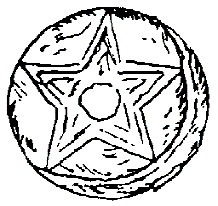
Sumeria
circa 3000 B.C.E.
One of the Shamash-Shamash, or Sun disks, this early pentacle represented not the Sun, but the Evenstar, BLANK (Venus). Symbolic of the Akkadian goddess Inanna and the Sumerian goddess Ishtar, it bore a striking and perhaps non-coincidental resemblance to the Mayan hieroglyph of noh ek (the planet Venus, associated with Quetzelcoatl).
|
Worth noting as an aside pertaining to the potentially non-coincidental similarity between both the pentacles and pentagrams of ancient Egypt and those of Mesopotamia and this Mesopotamian pentacle and the later Mesoamerican hieroglyphic pentagram is the similarity between the Sumerian ziggurats, the Egyptian true pyramids, and the later truncated Mesoamerican stepped pyramids, as well as evidence of the ritual smoking of Cannabis, thought to be native to southern Asia, in Neolithic Eurasian cultures and the presence of tobacco, generally considered as endemic to the Americas until European contact with the Caribbean, resin in ancient Egyptian smoking instruments. While the easiest explanation for such coincidents is to hypothesize hitherto unknown trans-Pacific contact between the Middle East and Mesoamerica, a more tenuous influence stretching across the Southeast Asia and North America is certainly possible, with continuing cultural development in these regions obscuring the connection and leaving, if anything, now only unrecognizable traces behind.
Pentagram of Marduk
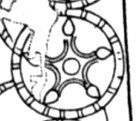
Babylonia
circa 900 B.C.E.
|
Nefer Seba Pentagram
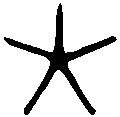
Khemet
circa
This early hieroglyphic pentagram was used to decorate ancient Egyptian tombs, used both as a simple element of tomb décor possibly symbolizing the endurance of the soul after death and as an adornment placed atop the heads of deceased individuals in ancient Egyptian artwork — with the depicted deceased persons pervading through the monster-ridden Duat (Underworld) in an attempt to reach BLANK — the abode of the Netjer — to find rest with their Gods. Possible meanings of the Nefer Seba include: star, door, portal, (sacred) opening, instruction, to teach or to instruct, school, pupil, and, in the transcription of foreign words, the letter S. The five points of the pentagram are said to have represented the five elements: earth, air, fire, water, and ether (or spirit).
|
While it is claimed that the Nefer Seba was actually a stylized starfish, the association of this symbol with the deceased and the association of deceased pharaohs with the stars makes this claim extraordinarily dubious; the hieroglyph’s usage strongly indicates that it was intended to be a star, albeit of a wholly disparate design from those of the Chaldean variety. This is further supported by the fact that Pythagoras, the presumed father of the modern pentagram, claimed to have been inspired by both Egyptian and Babylonian pentagrams in creating his Pentalpha. The comparison to the starfish should not lightly be disregarded, however, as the Egyptians believed that all life sprang from the sea; the starfish-pentagram, if that is truly what this pentagram is, can therefore be concluded to represent the Earth-womb and therefore the Underworld as a whole, bringing us back to its association with the deceased in a cosmological model so deftly illustrated by the Ankh; “As Above, So Below”, as the first line of The Emerald Tablet by Hermes Tresmagistus is so often paraphrased. Such multi-layered symbolism is common in occultism as well as ancient mythology. In either event — star or starfish, or even stick-figure man, the symbol does have five symmetrical points and is therefore a pentagram. Although mainstream researchers (de Vogel, et. al.) may push forth their contradictory starfish-and-therefore-not-pentagrams interpretation
Nefer Duat Pentagram

Khemet
circa
|
Egyptian Hieroglyph of Amen-Ra
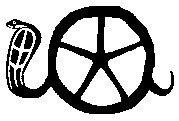
Khemet
circa
This theoretical nefer (hieroglyph) — an amalgam of the Nefer Seba and the Proto-Semitic hieroglyph of BLANK (the latter being identical to this hieroglyph but for its lack the central Seba) — incorporated the prominent Egyptian symbol of the Uraeus (cobra) into a Duat-like glyph that would have been used to represent the Netjer Amen-Ra. Its existence is strongly suggested by the later Pentangle of Amen-Ra, which was likely a modification of this unattested hieroglyph.
|
Pentangle of Amen-Ra

Khemet
circa
Used as the emblem of the Cult of Amen-Ra during the 11th Dynasty, this pentagram is one of the more symbolically significant in history. With the star in the center representing the five elements and the outer circle alluding to the hieroglyph of Duat, a representation of the earthen womb of the Underworld, the ouroboros surrounding the central star is the symbol of the Sun God, Amen-Ra — as the snake, shedding its skin each year, was a common representation of the solar cycle of the Earth and therefore the ram-headed Sun God himself. This symbol serves the modern Occultist as a reminder of the recurrent theme of interrelation between Light, Wisdom, the Serpent, and the Horned God.
|
Druid’s Foot

Somewhere, Europe
circa
|
Pentalpha of Pythagoras
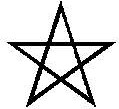
Samos, Greek Italy
circa 525 B.C.E.
|
Golden Ratio

Samos, Greek Italy
circa 525 B.C.E.
|
Pythagorean Ring

Samos, Greek Italy
circa 525 B.C.E.
|
Etruscan Pentagram

Volterra, Etrua
circa 500 B.C.E.
|
Empedoclesian Pentagram

Samos, Greek Italy
circa 475 B.C.E.
|
Jewish Pentagrams
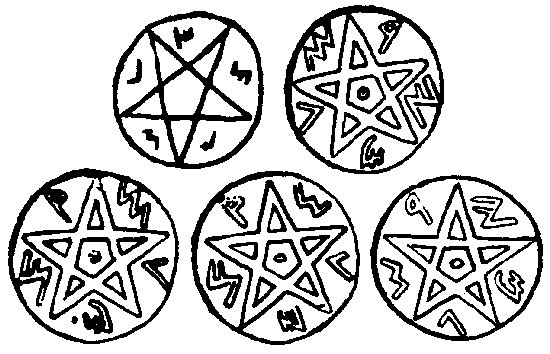
Jerusalem
circa 400 B.C.E.
|
City Seal of Jerusalem

Jerusalem
circa
|
Jewish Pentagram
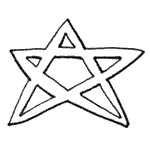
Judaea
circa
Blah blah blah.
|
The Endless Knot
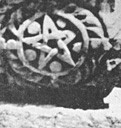
Capernaum
circa 300 C.E.
Blah blah blah.
|
Mayan Pentagram of Noh Ek
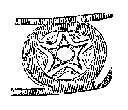
Mesoamerica
circa
The Mayan hieroglyph of noh ek (“great star”), also known as sastal ek (“bright star”), xux ek (“wasp star”), or chac ek (“red star”), very closely resembles the Venusian Shamash of Inanna-Ishtar: with its circular rather than pentagonal center and star’s double-bordered exterior, the only truly notable difference is the incurved rather than cornered spaces between its five points. The hieroglyph is also encircled, much like the Egyptian hieroglyph of Duat. That this symbol bore such similarities to both the Chaldean and Egyptian pentagrams is significant: Mesoamerican pyramids have the same general architectural style as the Sumerian ziggurats, with stepped ascents up to a plateau upon which sits housing presumably used for ritual, yet have a square base similar not to the rectangular base of the ziggurats but to the square base of the Egyptian pyramids, and rise high in a vaguely pyramid-shape rather than the more flattened shape of the ziggurats; evidence of the Mesoamerican herb Cannabis sativa can be found used as an embalming ingredient in ancient Egypt and was used ritually and medicinally in Neolithic Eurasia; the Egyptian god, Apophis: a winged, feathered serpent and rival of Amen-Ra: the highest Egyptian god and self-created father of the Netjer, was said to battle him for supremacy “beneath” (hence, on the opposite side of) the Earth, where the Mesoamerican cultures would later be known to worship various incarnations of their own highest god, Quetzecoatl — a feathered serpent. On the latter subject, mythologists are quick to point out that (i) Apophis was the Egyptian God of Chaos and was not at all alike Quetzecoatl in character, and (ii) Apophis predates the earliest known incarnation of Quetzelcoatl by thousands of years; however, one must remember that (i) it is not uncommon for one culture to demonize a respected god of another, or to deify the devil of another, and (ii) the earliest known example of anything is rarely if ever the actual earliest occurrence of it. It is unlikely mere coincidence that Venus, the star of the evening and the morning, was a symbol of Quetzecoatl among the Maya.
|
Breton Coin Pentagram
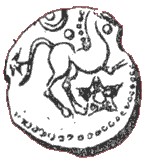
England
circa
|
Endless Knot
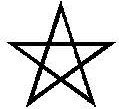
England
circa
|
Elemental Pentagram

England
circa
|
Pentagrams of Good & Evil

England
circa
|
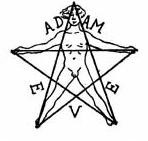
England
circa
|
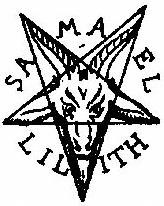
England
circa
|
Masonic Pentagram
Masonic Pentagram:
Pentagram of the Horned God
Mercurial Pentagram of the Goetia
Venusian Pentagram of the Goetia
Wiccan Witch’s Pentagram:
Wiccan Dedicant’s Pentagram:
Wiccan 1st Degree Pentagram:
Wiccan 2nd Degree Pentagram:
Wiccan 3rd Degree Pentagram:
Wiccan Pentagram of the Triple Goddess
Wiccan Pentagram of the Horned God
Gardnerian Pentagram
England, circa 1945 C.E.
LaVeyan Satanist Pentagram
San Francisco, California, circa 1965 C.E.
Alexandrian Pentacle
England, circa 1970 C.E.
|

























